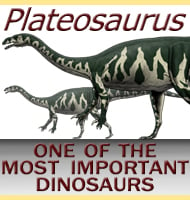In Depth
The metriorhynchids are the best known of the thalattosuchians, a group of crocodiles that had adapted themselves to life at sea. Out of these, Tyrannoneustes is considered to be a geosaurine metriorhynchid, (more closely related to genera like Geosaurus). It took quite some time for Tyrannoneustes to be named though, as the fossils were first recovered in 1906 and 1907 by a fossil hunter named Albert Leeds. Not considered to be anything special, the remains were left in museum storage for over a century until it was realised that they represented a new genus.
Studies of the jaw of Tyrannoneustes have revealed that these metriorhynchids had a notably wide gape when they opened their mouths to the maximum extent. In addition to this wide gape, the teeth were large and blade like, perfect for slicing into the bodies of prey. These two observations together strongly suggest that Tyrannoneustes would attack large prey animals ranging to be anything from plesiosaurs, to possibly even biting chunks out of large filter feeding fish such as Leedsichthys (which coincidentally was named after Albert Leeds, the person who discovered the Tyrannoneustes holotype fossils).
The holotype remains of Tyrannoneustes include a jaw that was roughly about sixty-six centimetres long, though the rest of the post cranial skeleton is only partially represented. In the absence of other specimens it seems that Tyrannoneustes was actually fairly small or at least within the lower average of its other geosaurine brethren. Indeed, a relative and similar named genus called Torvoneustes is thought to have grown just a little short of five meters. Another genus named Plesiosuchus that lived after Tyrannoneustes during the late Jurassic is known to have grown to just short of seven meters long, at least roughly double the size of the Tyrannoneustes holotype.
Although a predator in its own right, Tyrannoneustes would have needed to watch out for other larger oceanic predators, These may have included large sharks and ichthysaurs, but of a principal threat to Tyrannoneustes and other smaller thalattosuchians, would have been the pliosaurs, with genera such as Simolestes and Liopleurodon known to have likely been swimming in the same waters at the same time as Tyrannoneustes.
Further Reading
- The oldest known metriorhynchid super-predator: a new genus and species from the Middle Jurassic of England, with implications for serration and mandibular evolution in predacious clades - Journal of Systematic Palaeontology - M. T. Young, M. B. d. Andrade, S. L. Brusatte, M. Sakamoto & J. Liston - 2013. – The first record of Tyrannoneustes (Thalattosuchia: Metriorhynchidae): a complete skull from the Callovian (late Middle Jurassic) of Germany. – PalZ 92, 457–480. – K. Waskow, D. Grzegorczyk & P. M. Sander – 2018.










